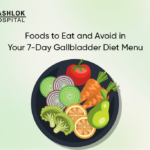Exercise for Gall Bladder Stone: Improve Your Recovery

Gallstones can greatly affect your quality of life if not treated within time. However, after a gallstone removal
surgery, one might become much weaker due to extensive surgical straining. One of the best remedies to improve the
pace of recovery from your gallstone removal surgery is exercise. Practicing mild to moderate exercise for gall
bladder stone can enhance your overall health and help with pain management. This blog shares brief insights into
the benefits of exercises for gallstone recovery and the best ones to practice.
Also, are you seeking the best medical care for gallbladder stone removal and recovery? Aashlok Hospital in Delhi is
one of the leading NABH-accredited multi-specialist hospitals. Consult the best Gastroenterologists in India to get
considerable guidance on gallbladder stone surgery and recovery.
Read More : Exercise for Gall Bladder Stone: Get Fast Relief Naturally
Types of Gallstones
Gallbladder stones can be classified into cholesterol gallstones and pigment gallbladder stones. Here’s a detailed
insight into the following types of gallstones:
Cholesterol Gallstones
Cholesterol gallstones are the most common type, accounting for approximately 80% of all gallstones. With a typical
yellowish-green hue, these stones are mainly cholesterol and small amounts of bilirubin and calcium salts. The
imbalance in the body’s cholesterol and bile salts leads to the formation of cholesterol gallstones. The major
factors contributing to the formation of cholesterol gallstones include high levels of cholesterol, obesity,
diabetes, family history, age over 40, sedentary lifestyle, etc. We at Aashlok Hospital utilize the latest
infrastructure to cure cholesterol gallstones. Book an appointment with our specialized healthcare team today!
Pigment Gallstones
Compared to cholesterol gallbladder stones, Pigment gallstones are much smaller, darker, and more fragile. These
deposits are mainly composed of bilirubin and calcium salts, with minimum amounts of cholesterol. These stones form
when there is an excess of bilirubin in the bile, often due to liver disease, hemolytic anemia, biliary tract
infections, or genetic disorders. Pigment gallstones can be further classified into black pigment stones, brown
pigment stones, mixed gallstones, and other rate categories. Our leading gastroenterologists at Aashlok Hospital can
efficiently understand the type of gallstones that develop in your body and determine the best course of treatment
and prevention strategies.
Read More : Exercise for Gall Bladder Stone: A Complete Guide for Pain Relief
Risk Factors for Gallstones
Understanding the risk factors can help you stay aware and take all the necessary preventive measures to reduce your
possibility of developing gallbladder stones. Visit Aashlok Hospital, the best healthcare provider, for personalized
guidance on understanding the risk factors and treatment approaches for gallbladder stones. The major risk factors
are:
Lifestyle Risk Factors
A sedentary lifestyle is largely responsible for the development of gallstones. If you consume a diet rich in
cholesterol, fat, and sugar, and low in fiber, it can positively contribute to gallstone formation. An obesity-rich
diet can also trigger gallstone formation since excess weight increases the pressure on the gallbladder and bile
ducts. Thus, living a sedentary lifestyle with no physical activities and excessive smoking and drinking stands as a
major risk factor for gallbladder stone formation.
Genetic Risk Factors
Genetic factors play a significant role in gallstone development. Individuals with a family history of gallstones are
more likely to develop these bile deposits than people with a clean genetic record. Certain gene mutations can
affect bile salt transport proteins, thus increasing gallstone risk.
Medical Conditions
Various medical conditions trigger gallstone risk such as diabetes, high blood pressure, high cholesterol levels,
cirrhosis, liver failure, hemolytic anemia, etc. Other medical conditions like Crohn’s disease, ulcerative colitis,
and intestinal bypass surgery, can increase the risk of gallstone formation as well.
Also Read : Comprehensive Guide to Gallstones Treatment
Best Recovery Exercise for Gall Bladder Stones
Exercising after gallstone removal surgery is an excellent recovery measure to follow. Our medical team at Aashlok
Hospital suggests practicing low-impact and gentle physical activities to ensure optimal safety and to avoid
straining the body too much after treatment.
Also Read : Gallbladder Removal Surgery: Debunking Common Myths
So, here are the most effective exercise for gall bladder stone you can practice after the surgery to pace up your
recovery:
Yoga Poses
The best gallstones yoga poses to follow for efficient recovery after the surgery are:
Child’s Pose (Balasana)
This yoga pose greatly stimulates the digestive system, making it much easier for the patient to digest food. To
perform this exercise, first, kneel on the mat and sit back on your heels in a relaxing position. Then, stretch out
your arms by lowering your forehead to the ground. This yoga pose will induce better relaxation and help manage
stress efficiently.
Cat-Cow Pose (Marjaryasana-Bitilasana)
After gallbladder stone surgery, the bile flow gets affected. This yoga pose can considerably enhance digestion and
improve bile flow. To perform this exercise, start with your hands and knees. Sit in the position of a cat, and
inhale deeply. Now, after 2 to 5 seconds, exhale deeply assuming the shape of a cow. Practicing this gallstones yoga
pose every day can induce much better spine flexibility.
Downward-Facing Dog (Adho Mukha Svanasana)
Stimulating the liver and gallbladder post-surgery is necessary to pace up your recovery. You can practice this yoga
pose every day to improve your recovery. To practice this yoga position, use your hands and knees to kneel on the
ground, assuming the position of a dog and then bend forward but keep your back lifted. Stay in this position for 5
to 7 seconds, and then release your hold. It elevates abdominal flexibility.
Physical Activities
The best physical activities to practice after a gallbladder stone removal surgery are:
Brisk Walking
Brisk walking for 15 to 30 minutes daily can support better digestion and improve your bile flow. However, ensure not
to push yourself too much since it can have adverse impacts. So, practice for brief sessions in the beginning and
gradually increase your duration as you recover.
Swimming
Swimming is an excellent physical activity for bringing your health back on track. It is a low-impact exercise for
gall bladder stones that can considerably reduce abdominal straining, improve abdominal elasticity, and facilitate
better digestion. However, we recommend you practice in a small pool at the beginning since it might not be possible
for you to withstand waves.
Cycling
If you are looking for simple physical activities to speed up your recovery after gallstone removal, cycling can be
one of the best options. It can greatly stimulate your digestive system and boost bile production. However, do not
ride sports cycles since they can be very straining to use.
Also Read : Gallstones- a stone to be removed from your body
How can Exercise for Gall Bladder Stone Aid the recovery process?
This is how exercising every day after gallstone removal can facilitate better recovery:
Physical Benefits
Doing exercise for gall bladder stones every day can stimulate intestinal movement, thereby boosting bile flow and
digestion. It also improves gut mobility and reduces inflammation, which is a leading cause of gallstone formation.
Psychological Benefits
Practicing regular physical activities can greatly influence hormones to maintain the stability of your body’s
cholesterol and insulin levels. It can also promote better insulin sensitivity and boost the immune system to reduce
the chances of gallstone formation.
Mechanical Benefits
You can avail of mechanical benefits like gallbladder contraction and bile duct clearance with regular physical
activities. Gallbladder contraction facilitates in expelling of small stones and the bile duct clearance mechanism
reduces the possibilities of gallstone formation by clearing bile ducts of the body.
Also Read : 5 Foods to Avoid in Gallstones
Final Words
Exercising every day can have a considerable positive impact on your health after gallstone surgery, so we recommend
you practice the above-mentioned exercise for gall bladder stone. You can also consult our Gastroenterology team at
Aashlok Hospital for incredible assistance with
gallstone recovery and management.









